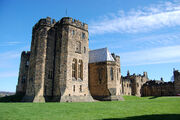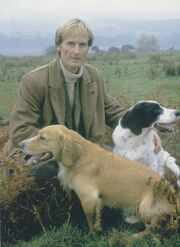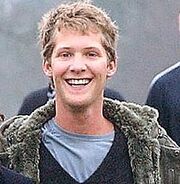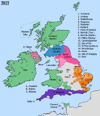| |||||||
| Capital | Alnwick | ||||||
| Language official |
English | ||||||
| others | Northumbrian, Pitmatic, Cumbric | ||||||
| Demonym | Northumbria | ||||||
| Government | Democracy | ||||||
| Area | 9198 km2 (3551 sq mi) km² | ||||||
| Population | 136,000 | ||||||
| Established | 21st November 1993 | ||||||
| Currency | Cleveland Pound | ||||||
History
Doomsday
The English counties of Northumberland, Tyne and Wear and Durham are hit by three nuclear explosions:
- one 200 Kiloton bomb on Newcastle
- one 200 Kiloton bomb on Sunderland
- one 100 Kiloton bomb on Durham
Other tactical nuclear weapons (10KT) fell on military bases in and around the area:
- RAF Boulmer
- RAF Ouston - shared with British Army
- The Otterburn training range
Aftermath
The outright death toll was well over one million. However, with the majority of the nuclear explosions taking place in the Tyne and Wear valleys the radioactive fallout from the blasts to the majority of the Northumberland was greatly reduced.
Within three days refugees began arriving in the south of the region, many died due to the effects of the radiation, mass graves were dug during October near the town of Morpeth.
With the collapse of the UK government, the 10th Duke of Northumberland, Hugh Algernon Percy, in his capacity as the Lord Lieutenant of Northumberland, began to organize a basic police and military force to try to regain order.
On the 25th Septmeber 1983, he sent out messengers (including his three sons Henry, Ralph and James) on horses to nearby towns of Alnmouth, Seahouses, Brinkburn, Wooler, Bamburgh, Lindesfarne Island, Amble, Morpeth, Blyth, Ashington, Newbiggin-by-the-Sea, and Rothbury carrying a notice that anyone with any military service (including national service), police service, or experience that may be useful (gamekeepers, etc, even people trained in karate/judo) regardless of age to report to Alnwick castle by the 1st October 1983.
In total 874 men and 73 women arrived in Alnwick. They ranged in age from 15 year old military cadets to seventeen World War I veterans in their eighties and nineties.
Included in the volunteers are 35 American students and teachers, based in Alnwick Castle from St Cloud State University from Minnesota, USA.
The new recruits were included into the reformed Percy Tenentry Military Volunteers, armed from the castle armoury and divided into three divisions of 250 personnel they were sent out into the Northumberland countryside to maintain order in the name of the Duke.
Contact with the rest of the UK was lost immediately after Doomsday, however within one month contact had been made with areas running from Berwick Upon Tweed in the north to the outskirts of the north Tyne Valley and up to the tops of the Pennines.
The Duke of Northumberland's main residence is at Alnwick Castle.

Alnwick Castle
However due to his exposure to the radioactive fallout in the south of Northumberland, he died due to lung cancer on 11 October 1984 and was succeeded by his son Henry Alan Walter Richard Percy who became the 11th Duke of Northumberland.
On the January 22nd 1990, Henry, the 11th Duke, announces the resumption of the Scoring of the Hales.
The Scoring the Hales is the name of a large scale Shrovetide football match played yearly in Alnwick, Northumberland. Once a street contest, it has now moved to a field named The Pasture across the River Aln from Alnwick Castle. The match involves about 150 men on either side and is a contest between the parishes of St Michael and St Paul. The goals are decorated with greenery and stand about 400 yards apart.
The game starts with the ball being sent over the Barbican of the Castle to the crowd assembled below. It was then kicked through the streets of the town. The game goes towards Bondgate Tower and from there to the pastures.
Nowadays the ball is fetched from the castle in procession, preceded by the King of Northumbria's piper. The game is won by whichever team is first to score 2 "hales" or goals, after which the ball is carried to the river and thrown in. Whoever manages to get it out at the far side of the river is allowed to keep the ball, but they have to swim the River Aln to get it.
Kings of Northumbria
After discussions with his brothers Ralph and James, and his mother, Lady Elizabeth, Henry Percy, 11th Duke of Northumberland officially renamed himself Henry I, King of Northumbria on 21 November 1993, upon this announcement he declared the former counties of Northumberland and also non-radiated parts of Tyne and Wear to become the Kingdom of Northumbria, regaining the name for the area that had been used from 654 - 954 AD.
He declared that a parliament would be formed based at Bamburgh Castle on the North Sea coast.
Bamburgh Castle

King George

Crown Prince George
King Henry died suddenly in his sleep on 31 October 1995, without advanced medical technology it is assumed that he had a stroke. He was succeeded by his younger brother Ralph George Algernon Percy who became King George of Northumbria.
In 1979, the then Lord Ralph Percy married Isobel Jane Richard, and with her has had four children:
- Princess Catherine Sarah Percy (b. 23 June 1982 - d. 25th Jan 2006 - died in fall from horse)
- Crown Prince George Dominic Percy (b. 4 May 1984)
- Princess Melissa Jane Percy (b. 20 May 1987)
- Prince Max Ralph Percy (b. 26 May 1990)
Parliament
The Northumbrian Parliament is based on the Anglo-saxon Witenagemot or Witain.
It is based on 22 members which are elected (as members of parliament) and take the title thaine,
These areas which are represented by Thaines are :
- Berwick-upon-Tweed - James Johnstone
- Allendale - Michael King
- Acomb - Hillary Marham
- Amble - Matthew Potts
- Alnwick - Harold Sperritt
- Belford - William Robson
- Carlisle - Francine Marshall
- Chevington - Michael Charlton
- Ellington - Emily Dodds
- Felton - Jenny Maclare
- Rothbury - Alexander Armstrong
- Lesbury - Paul Elliot
- Longhoughton - John Charlton
- Longframlington - Peter Robson
- Newton-on-the-Moor - Jackson Armstrong
- Morpeth - Alexander Hall
- Ord - Anthony Graham
- Ponteland - Karl Ayre
- Shilbottle - Abigail Townsend
- Warkworth - Aaron Jones
- Widderington - Colin Lambton
- Workington - Michael Barker
On the 6th of May 2011 two new members of the Witain will be elected from the former Rheged Co-Operative, these members will come from Carlisle and Workington.
These Thaines along with the King (who has the deciding vote), and most senior male member of the royal family (currently the Crown Prince George) - these are the secular side of the Witain
There are also 10 members elected from the church, usually Bishops or Arch-bishops but occasionally local vicars.
Elections of thaines are held every four years on the 1st Sunday of June. Every person in the kingdom can vote for his or her local thaine as long as:
- They are over 18 years old.
- They have full mental faculties.
- They have served one year or more in local service (military, emergency services, unpaid public service work such as road building etc.)
NEWS
19 February 2012
The Albion Railway Company along with the Northumbrian Witain have announced the renovation of the former west coast main line linking Carlisle with the Duchy of Lancaster, Once this line has been completed (with a provisional date of mid August 2012) another line will be laid on the A74 and will link the Celtic Alliance city of Glasgow with Carlisle.
Provisional train stations will be for the completed line will be Glasgow (CA), Motherwell (CA), Lockerbie (CA), Carlisle (Northumbria), Penrith (WFT), Oxenholme (WFT) and Lancaster (Duchy of Lancaster).
War with Ur Alba
Final casualty reports have been announced for the Ur Alba War, with the Northumbrian Army loosing 12 troops and injured 72 and the Rheged Militia lost 22 troops and had 29 injured.
Unification of the Kingdoms of Northumbria and Cleveland
On the 22nd April 2007 it was announced that Crown Prince of Northumbria, George Dominic Percy is dating the Crown Princess Zara of Cleveland. On the 5th August 2008 it was announced that the Crown Prince of Northumbria, George Dominic Percy is engaged to the Crown Princess Zara of Cleveland. The wedding date was set for 4 November 2009. Prince Max Percy (Crown Prince George's younger brother) was best man.
This wedding and any children issuing from the marriage will unite the Kingdoms of Northumbria and Cleveland. it has been announced that the primogeniture rule (male children having right of rule over older female siblings) has been abolished and the eldest child (no matter the sex) will rule both the kingdom of Northumbria and Cleveland.
The wedding took place at Richmond Castle. Upon the accession of the then King George and Queen Zara to their respective thrones the kingdoms shall unite under the name of the United Kingdoms of Northumbria and Cleveland or UKNC
Upon the accession of the first child of Zara and George (Prince Michael James George Percy) to both thrones, the Kingdoms unite as one Kingdom and will change their names to the Kingdom of Albion.
On New Years Day 2010 it was announced from the Royal Palace of Wynyard that the Crown Princess Zara and her husband Crown Prince George are expecting their first child, it is expected to be born mid August.
15 May 2010 it is announced that Princess Regent Zara is pregnant with identical twin boys.
9 August 2010, as 4.13am Princess Regent Zara, accompanied by Crown Prince George attended James Cook University Hospital in Middlesbrough. At 4.42pm Princess Regent Zara gave birth to a baby boy (weighing 5 pounds 6 ounces) named Michael James George Percy and at 4.57pm she gave birth to another baby boy (5 pounds 2 ounces) named Edward Henry John Percy. Both boys are healthy.
On the 1st of January 2011 Princess Regent Zara comes to the throne of the Kingdom of Cleveland, she was crowned on the 15th January 2011. The entire Northumbria Royal family was in attendance.
Contact
By the late 1990's radio signals coming from Scotland are picked up in the north of the kingdom. These signals are from the Celtic Alliance (1983: Doomsday) and are general music stations as such no direct radio contact is made.
In 2004 a small group of fishing vessels make port in Alnwick, these fishing vessels are from a Kingdom to the south of the nuclear wasteland of the Tyne and Wear valleys known as the Kingdom of Cleveland (1983: Doomsday) ruled by Queen Anne II oldest child of the former Queen of the UK Elizabeth II (who was King Henry's godmother)
In late 2008 a joint mission from the Kingdoms of Cleveland and Northumbria contacted the Celtic Alliance (1983: Doomsday) for the development of trade between the two areas.
Military
Army
The Northumbrian Royal Army (NRA) is responsible for protecting settlements and raider prevention from the border regions of the former county of Cumbria.
The armed forces consist of:
- One unit of Housecarls, the most elite unit consisting of 120 men armed with heavy two handed axes and 9mm handguns, tasked with protecting the King, royal family and Members of Parliament.
- Four units of heavy cavalry on Clydesdale and Shire Horses, armed with five foot long broadswords, each unit containing 50 men.
- Three units of light cavalry, riding smaller former hunting horses armed with short swords, each unit containing 50 men.
- Six units of archers, armed with crossbows and longbows, with 9mm sidearms and small knifes, each unit containing 150 men.
- Five units of general infantry, armed with basic rifles, pikes, bilhooks and knives, each unit consists of 200 men.
- One unit of artillery, armed with five 150mm howitzers salvaged from Otterburn military ranges.
Navy
The Northumbrian Royal Navy (NRN) is limited to small inshore boats and converted trawlers and there operational capability depends on the availability of diesel which is in short supply. Plans are underway to buy several small steam vessels from Cleveland
Air force
The Northumbrian Royal Air force (NRAF) is very small consisting of several small Cessna airplanes and one Sea King air rescue helicopter (formally based at RAF Boulmer however was on a sea rescue mission at the point of DD) flights are limited due to lack of fuel.
In 2011 the Northumbrian Sea King went to the Celtic Alliance for a complete refit.
Militia
Every able bodied citizen of Northumbria aged 19 to 45 are part of the Northumbria Militia (like the ATL Swiss militia), at the age of 18 every citizen is given compulsory 3 months training in weapons and military tactics. All members of the Northumbria Militia provide their own weaponry, however most are small arms such as pistols, some people only have home made bils or pikes. It is estimated that there are 65,000 people in the Northumbria Militia.
In 2009 members of the Royal Cleveland Territorial Army came to Northumbria to train the Northumbria Militia and turn sections of it into the Royal Northumbrian Territorial Army which was created in mid 2011.
The new Royal Northumbrian Territorial Army is formed of four regiments with 400 troops in each, the regiments are:
- The King's own Hussars
- Royal Northumbrian Fusilliers
- Cumberland Hussars - former Rheged Militia
- Northumbrian Yeomanry
Rheged Militia
With the incorporation of Rheged into the Kingdom of Northumbria in 2011, the Rheged Militia became part of the Northumbrian Army. It is expected that it will become its own separate division in the Royal Northumbrian Territorial Army.
Transport
In 2009 the government of the Kingdom of Northumbria places an order for five new coal powered locomotives from a loco works in Darlington in the Kingdom of Cleveland, they will be completed between early 2011 and late 2011.
One locomotive has been certified for service with Northumbrian Railways
- 60170 - Kingdom of Northumbria - Certified January 2011
Four more locomotives are still being built for Northumbrian Railways, they will be completed between mid 2011 and late 2013.
- 60171 - King George - Completed February 2011, certified June 2011.
- 60172 - Lindisfarne Abbey - Completed July 2011, certified August 2011
- 60173 - Bamburgh Castle - Completed September 2011, certified October 2011
- 60174 - Alnwick Castle - Completed December 2011, certified January 2012
Bilton loco works
In late 2010 engineers from the Kingdom of Cleveland will travel north to Northumbria to set up another locomotive building works in Bilton near Alnwick, the building was completed in early October 2010, machinery fully installed by December 2010 and was ready for the arrival of Northumbria's first new locomotive (Kingdom of Northumbria) in January 2011.
The new Loco works at Bilton will begin the manufacture of a modified version of the M7 class tank engine from 1911 in mid 2011. The first three produced will go the Cleveland in thanks for setting the works up.
The three new Tank engines will be called:
- 125 - Derwent
- 126 - Ouse
- 127 - Humber
After these Cleveland Tank engines are completed then work will begin of four more for Northumbria.
- 128 - Tweed - Completed November 2011
- 129 - Tyne - Completed December 2011
- 130 - Wansbeck - Completed January 2012
- 131 - Coquet. - Completed February 2012.
Northumbria has also taken orders for six Tank engines from the government of Newolland for use in their newly reopened coal mines in Northern Nottinghamshire.
- 129 - The Great Ouse - Completed March 2012.
- 130 - The River Ancholme - Completed June 2012.
- 131 - The River Slea - Completed July 2012.
- 132 - The River Nene, Completed August 2012.
- 133 - The River Welland, Completed October 2012.
- 134 - The River Glen, Completed December 2012.
| ||||||||||||||||||||||
| ||||||||||||||||||||||




